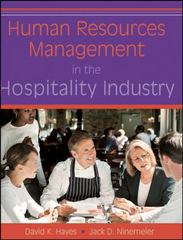Question
The hospitality industry includes restaurants, cafes, caterers, clubs, pubs and hotels. It ranges from family-run coffee shops to five-star resorts. There are more than 10,000
The hospitality industry includes restaurants, cafes, caterers, clubs, pubs and hotels. It ranges from family-run coffee shops to five-star resorts.
There are more than 10,000 cafes and 1000 catering businesses in NSW. Together they employ about 60,000 workers. The NSW hotel industry employs over 50,000 workers and clubs employ more than 40,000 workers. Many of the workers in hospitality are considered vulnerable workers and generally work part-time, late nights and weekends. Many come from multi-cultural backgrounds and speak limited English.
According to Safework NSW, over the past three years more than 18,000 workers were injured in the NSW hospitality industry. More than 250 were permanently disabled and eight died. This project has five tasks, the first four tasks will prepare you for the final task is to design and develop a safety audit check sheet for your organisation. Task one you will need to address the following questions:
Task 1: Establish and maintain a framework for health, safety and security.
1. Why do we access and interpret key legislative documents to ensure WHS system complies with regulatory requirements, standards and codes.
2. How do we ensure that the WHS management system is contextualised to suit characteristics and needs of the organisation, in consultation with appropriate personnel?
3. Detail why it is beneficial to utilise the financial, human and specialist external resources to address WHS management practices.
4. Nominate two examples of how you could ensure that WHS policies and procedures are communicated in a format readily accessible and understood by all team members.
5. Why do outline and allocate health, safety and security responsibilities within relevant job descriptions?
6. What are the PCBU's duty to Consult with key personnel, and develop and implement a plan for WHS training requirements?
7. What are the requirements for establishing and monitoring a system for keeping WHS records?
8. Provide two methods that may be utilised to ensure communication of WHS information to personnel.
Consultation and collaboration with all team members is not just a good idea it legal responsibility of the PCBU. The team members all have differing levels of skill, knowledge and experience, this could be used to improve the safety of your workplace. Task two you need to complete the information required.
Task 2: Establish and maintain consultative arrangements for the management of health, safety and security.
1. How do we maintain appropriate consultative processes to suit characteristics and needs of organisation?
2. Why must we plan for and ensure that consultation is conducted at times designated by legislation?
3. Outline why it is best to resolve issues raised through consultation.
4. Provide employees with accessible information on the outcomes of consultation.
Task 3: Establish and maintain practices for identifying hazards, and assessing and controlling risks.
Organisations need to have a system in place that will identify, analyse and control hazards. Every team member must know their part in ensuring the safe working environment. In task 3 you are required to complete the following questions:
1. Provide an example of a hazard identification and risk assessment template that incorporate criteria for assessing risks
2. Plan for and ensure systematic hazard identification at times designated by legislation.
3. Nominate two procedures for the ongoing identification of types of hazards designated by legislation.
4. Develop procedures for the assessment and control of risks associated with identified hazards.
5. Why must we make sure the team members comprehend the procedures the roles and responsibilities for hazard identification, risk assessment and risk control?
6. Explain why it is vital to be proactive in controlling risks, including implementing interim or emergency solutions.
7. How do we manage the response to any incident or accident, and follow legislative requirements for notifying and cooperating with WHS government regulators?
As a continuous improvement culture we always strive to improve our performance in every area of or organisation. There is no difference when it comes to WHS & Security. We must all be alert for hazards and our system must be closely monitored to ensure that it remains compliant. Address the elements in task 4:
Task 4: Evaluate organisational health, safety and security system.
1. Assess and maintain ongoing compliance with WHS legislation and regulatory requirements, standards and codes.
2. Why do need to consult with a range of personnel to elicit feedback on WHS policies, procedures and practices?
3. How do we assess the WHS management practices, and in response develop, implement, document and communicate improvements and changes to the WHS system?
Step by Step Solution
There are 3 Steps involved in it
Step: 1

Get Instant Access to Expert-Tailored Solutions
See step-by-step solutions with expert insights and AI powered tools for academic success
Step: 2

Step: 3

Ace Your Homework with AI
Get the answers you need in no time with our AI-driven, step-by-step assistance
Get Started


